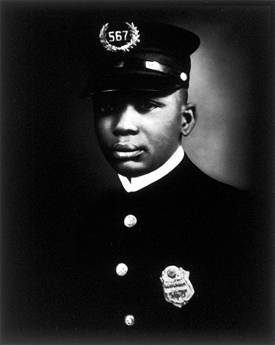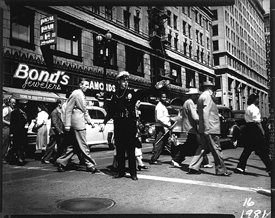| .........
LAPD Archive Photos
Preserving an Invaluable Photographic Legacy
~~~~~~~~~~~~~~~~~~~~~~~~~~~~~~~~~~~~~~~~~~~~~~~~~~~~~~~~~~~~~~~~~~~~~~~~~~~~~~~~~~~~~
 |
.
 |
|
LAPD Archive Photos
Preserving an Invaluable Photographic Legacy
by Kevin Maiberger
March 25, 2008
The Los Angeles Police Department has embarked on an ambitious plan to catalog and preserve nearly one million photographic negatives accumulated during decades of police service in the city of Los Angeles. The images constitute a visual record dating primarily from the early 1920s to the late 1960s.
“Our agency has a rich heritage that parallels and reflects the history of the city,” remarked Mary Grady, Public Information Director for the LAPD, whose Entertainment Trademark Unit will coordinate the undertaking. “The Department has played a vital role in every era of the city's past. So it is fitting that these negatives should now offer a unique visual resource, one derived entirely from a law enforcement perspective. The photos are expected to be a great help to anyone wanting to learn more about Los Angeles and the LAPD. We envision the portfolio becoming an important tool for interested parties from many different backgrounds, including historians, journalists, entertainment professionals, students, private citizens, and other law enforcement agencies.” |
While LAPD archival photographs are and have been available in recent years (see www.FOTOTEKA.com), they represent just a fraction of the full collection of film negatives. In total, more than 960,000 photo negatives are housed at several film vaults around the city. Until now the images have remained largely forgotten and unexplored.
Because of the project's magnitude, the City has opted to outsource the task of establishing a database for digital scans of each negative. The work will involve sorting, identifying, and electronically scanning every image. The newly digitized files will then populate a database capable of accommodating queries based on any number of search criteria. |
.
This spring the City will announce a formal Request for Proposal (RFP) for companies wishing to be considered for the project. Including the bid phase, the full venture is expected to last several years.
Most of the negatives have minimal or no supporting documentation. Therefore, the Department will enlist the help of scores of retired LAPD officers in the hope that their collective memory will aid in attributing correct date, time, location and content to each photograph. “Our retired officers are a tremendous asset. We want to tap into their memories and employ their expertise as much as possible,” said Grady.
While all of the images will be subject to existing copyright restrictions, with ownership retained by the City, the photographs will be licensed for use. “We want the pictures to be utilized in ways that maximize their benefit to the most number of people,” Grady stated. |
|
 |
.
“Once things get started, no one knows what treasures we may find. Many of the negatives haven't been seen for years. We're actually not sure what's in there,” Grady said. “Much interest is expected based on the police-oriented content of the images, but we also recognize a fascination with historical photographs in general. People outside the field of law enforcement are also expected to take notice. Old photographs capture subtle details and nuances of their time, often in ways not intended by either subject or photographer. Years or decades later, significance is in the eye of the beholder.”
The database will serve not only as testimony to the LAPD's past, but provide a means of capturing the Department's visual history for the years ahead. “Every day, the business of policing adds new negatives to the library,” said Grady. “Our obligation is to organize and safeguard these images in ways that will make them accessible, meaningful, and useful for generations to come. The LAPD's past is, in many ways, it's future. We must preserve it.” |
|
 |

|